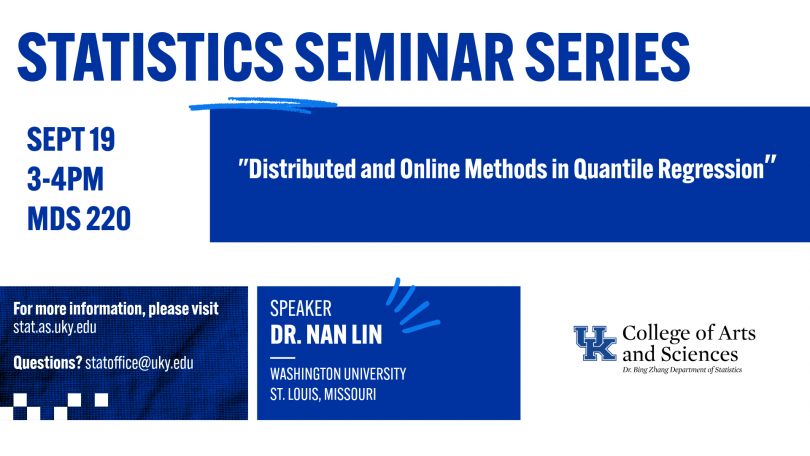2025 van Winter Lecture in Mathematical Physics


By Francis Von Mann
LEXINGTON, Ky. (September 3, 2025) - The energy on campus is palpable. Every fall, new Wildcats arrive from across the Commonwealth and beyond to begin a new chapter in Lexington.
Title: Distributed and Online Methods in Quantile Regression
Abstract: Quantile regression offers a versatile framework for modeling heterogeneous effects, but modern big data present significant computational and methodological challenges. This talk will trace a line of research on distributed and online approaches for quantile regression and related problems. In this talk, I will discuss a sequence of developments in distributed and online approaches for quantile regression, drawing connections to both classical estimation strategies and more recent advances in causal inference. I will highlight key ideas, recent progress, and future directions, with an emphasis on algorithmic insights and their relevance for large-scale applications.

Dr. Adam Smercina, Space Telescope Science Institute
Title: A New Era of Galaxy Evolution using Resolved Stars
Abstract: The varied and dynamic evolutionary histories of galaxies give rise to their stunning diversity in the present-day universe. Inferring these histories requires accessing the information encoded in their longest-lived visible components: stars. We are in an exciting new frontier, with a fleet of current and upcoming observatories capable of accessing the resolved stellar populations within and around external galaxies. In this talk, I will first summarize my efforts to chart the merger histories of nearby galaxies by surveying the stars in their accreted halos, including the exciting potential of the upcoming Roman Space Telescope. I will then discuss my efforts to trace the evolution of these galaxies star formation and structure, particularly as a consequence of their merger histories, through high-resolution surveys of their main bodies. In particular, I will highlight several large programs with JWST, which has opened up an exciting new frontier for this science. Over the next decade, these efforts with JWST and Roman have the potential to transform our view of galaxy evolution. To close, I will discuss how this current pioneering work with JWST will pave way for the next paradigm shift in resolved star science: the Habitable Worlds Observatory.
Abstract: Synthetic DNA nanotechnology facilitates the design and fabrication of nanoscale particles and devices with diverse applications. Leveraging a growing toolkit of DNA self-assembly methods, it is possible to construct both two- and three-dimensional structures ranging from nanometer to micron scales. The biophysical and biochemical properties of DNA — combined with its compatibility with various organic and inorganic nanoparticles and its predictable base-pairing rules — have made it an ideal material for single-molecule studies, photonics, plasmonics, synthetic biology and healthcare applications. In this work, we present our efforts in developing DNA-based platforms to organize inorganic and organic nanoparticles and biosensors precisely. We investigate how these DNA scaffolds can control the positioning and orientation of nanoparticles to enhance their photophysical properties. Additionally, we explore the behavior of DNA nanostructures when introduced into mammalian cell cytosol, a critical step toward creating biocompatible delivery systems for therapeutic and diagnostic purposes. Finally, we will discuss our recent efforts in building gene-encoded DNA nanoparticles, a promising advancement in the development of targeted delivery systems.

Website: https://www.mathurnanolab.com/